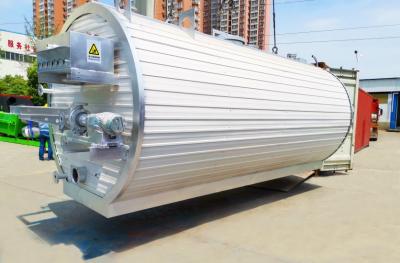Commercial concrete mixing plant
Commercial concrete mixing plant consists of mixing system, aggregate supply system, powder storage system, metering system, control system and external equipment.
Mixing System
The mixing system is divided into forced mixing and self-falling mixing according to its mixing method. Forced mixer is the mainstream of mixing plant at home and abroad, which can mix various kinds of concrete such as fluidity, semi-dry hardness and dry hardness. The self-falling mixer mainly mixes liquid concrete and is rarely used in mixing plants. The forced mixer is divided into spindle planetary mixer, single horizontal shaft mixer and double horizontal shaft mixer according to the structure form. Among them, the double horizontal shaft forced mixer has the best overall performance.
Aggregate supply system
Aggregate supply system consists of three parts: aggregate storage bin, aggregate metering hopper and aggregate conveying.
Aggregate conveying: There are two ways of aggregate conveying in mixing plant: hopper conveying and belt conveying. The advantages of hopper lifting are small footprint and simple structure. The advantages of belt conveying are large conveying distance, high efficiency and low failure rate. Belt conveying is mainly used in mixing plants with aggregate storage bins, thus increasing the productivity of the mixing plant.
Powder conveying: The main powders available for concrete are cement, fly ash and mineral powder. The commonly used powder conveying method is screw conveyor conveying, and large mixing plants use pneumatic conveying and scraper conveying. The advantages of screw conveying are simple structure, low cost and reliable use.
Liquid material conveying: mainly refers to water and liquid admixture, which are conveyed by water pump respectively.
Metering system
The metering system is a key component that affects the quality of concrete and the cost of concrete production, mainly divided into three parts: aggregate weighing, powder weighing and liquid weighing. In general, the mixing plant below 20 cubic meters per hour adopts the superposition weighing method, i.e. one scale for aggregate (sand and stone), one scale for cement and fly ash, and separate weighing for water and liquid admixture, and then the liquid admixture is put into the water weighing hopper for pre-mixing. In the mixing plant of more than 50 cubic meters per hour, each material is weighed independently, and all the weighing is controlled by electronic scale and microcomputer. The weighing accuracy of aggregates is ≤2%, and the weighing accuracy of cement, powder, water and admixture is ≤1%.
Control System
The control system of the mixing plant is the central nerve of the whole set of equipment. The control system has different functions and configurations according to different requirements of users and the size of the mixing plant. Generally speaking, the control system of small mixing plants available at construction sites is simpler, while the system of large mixing plants is relatively more complicated.
Supporting Equipment
Water circuit, air circuit, silo



